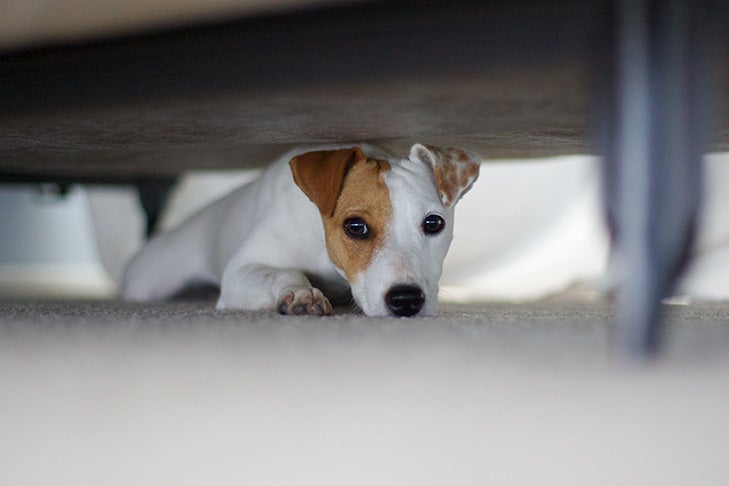AKC is a participant in affiliate advertising programs designed to provide a means for sites to earn advertising fees by advertising and linking to akc.org. If you purchase a product through this article, we may receive a portion of the sale.
You may have noticed that your dog often reacts to sounds you can’t detect, especially those at high frequencies. The average dog’s hearing is approximately four times stronger than the average person’s. The canine ear canal is much deeper than the human ear and serves as a better funnel of sound to the eardrum. In the days before canines became domesticated, detecting high-frequency sounds, like the squeaks made by small animals, was critical for survival.
Because of their hearing acuity, dogs are more vulnerable to pain, damage, and anxiety that intense, high-decibel sounds can cause. Recently, a variety of ear muffs designed for dogs are helping to protect canine hearing.

When Are Dog Ear Muffs Useful?
Gradual weakness in hearing is common in senior dogs, as it is in aging humans. When my Curly-Coated Retriever reached 10 years old, if I called his name, he often responded by running in the wrong direction. Hearing loss is a safety issue for dogs who can no longer identify exactly where sounds are coming from.
If you’re worried about your dog’s exposure to noise and can’t remove your dog from the situation or moderate the volume, dog ear muffs may be a good investment. Here are some situations where they can help:
Exposure to Intense Loud Noises
Hunting dogs and police dogs are exposed, as are their humans, to the sudden explosive noise of a gun. Research has shown that hunting dogs may experience injury to their inner ear that eventually causes hearing damage. Similarly, fireworks at near proximity may damage a dog’s hearing. Well-fitted, noise-reducing ear muffs can offer some protection.
Exposure to Noises of Lasting Duration
If you live in a city with constant traffic noise, your walks can be irrepressibly noisy to your dog. If you board your dog at a kennel, the barking of other dogs can be very stressful and cause hearing impairment. Dogs may also react to noises while traveling in cars, on public transportation, or on airplanes. In any of these situations, ear muffs can provide some relief.

Noise Sensitivity
Many dogs are noise-sensitive and suffer anxiety over an assortment of noises, including thunder, vacuum cleaners, smoke detectors, clothes dryers, or car alarms. Muffling those noises with ear muffs can calm your dog but should be coupled with behavior modification. Your dog is hearing the noise as well as feeling vibrations and sound waves, so ear muffs aren’t a one-shot solution, but they can help.
Grooming
Researchers did a study of industrial blow dryers used by some dog groomers. They found that the average noise level during several hours of low intensity had the potential to damage the hearing of the dogs and the groomer. Ear muffs could potentially protect dogs exposed to the noise for hours at a time.
Features to Consider When Purchasing Ear Muffs
There are numerous factors to consider when purchasing ear muffs for your dog. Here are a few things to think about when trying to determine which ear muffs are right for your dog’s needs:
Comfort
If your dog isn’t comfortable wearing the ear muffs you buy, they won’t be useful. Ear muffs come in different shapes with a choice of padding. Certain dog’s head shapes do better with rounded ear muffs. Some ear muffs have thicker padding than others, while some models are less intimidating to put on your dog’s head. If your dog is small, you’ll likely need lightweight ear muffs to make them feel comfortable.
Size
A Bulldog and a Papillon have vastly different head shapes and sizes. That’s why ear muffs are available in a variety of sizes, and some have straps to make them easily adjustable. Follow the manufacturer’s instructions and measure your dog carefully before you order. If ear muffs don’t fit right, they won’t cancel out the noise.
Noise Protection
The loudness and intensity of a sound are measured in decibel (dB) units. The human ear registers discomfort at around 120 dB and pain when noise reaches about 140 dB, while a dog’s hearing discomfort starts as low as 90 dB. Read what the manufacturers say about estimated decibel noise reduction based on testing. Advertised brands claim reductions from 21 to 29 decibels. Remember, you don’t want your dog’s ear muffs to cancel out all noise since this could be dangerous for them.
Materials
Dogs often shake their heads and bend down to sniff, so look for ear muffs made of non-breakable, lightweight materials, such as ABS plastic. If you try to introduce ear muffs, but your dog is too uncomfortable with their bulk, a stretchy soft material hood or snood might be calming in instances of noise anxiety. However, note that these options may not be as effective at reducing the noise level.

How to Introduce a Dog to Earmuffs
Teaching your dog to wear ear muffs in gradual, calm, and positive steps is critical if you want them to wear something so foreign. Remember to introduce your dog to wearing ear muffs in a familiar environment before any situation when they’ll need them, such as fireworks.
- First, put the ear muffs on the ground and let your dog see and sniff them. When the dog touches them, reward them with a treat.
- Next time you bring them out, slowly touch them to an ear and treat. Do this until your dog thinks nothing of it.
- Open the ear muffs and hold them gently on the dog’s head. Treat and remove quickly.
- Repeat putting the ear muffs on your dog without making any adjustments and giving treats for brief periods, but slightly longer each time until the dog is comfortable wearing them.

